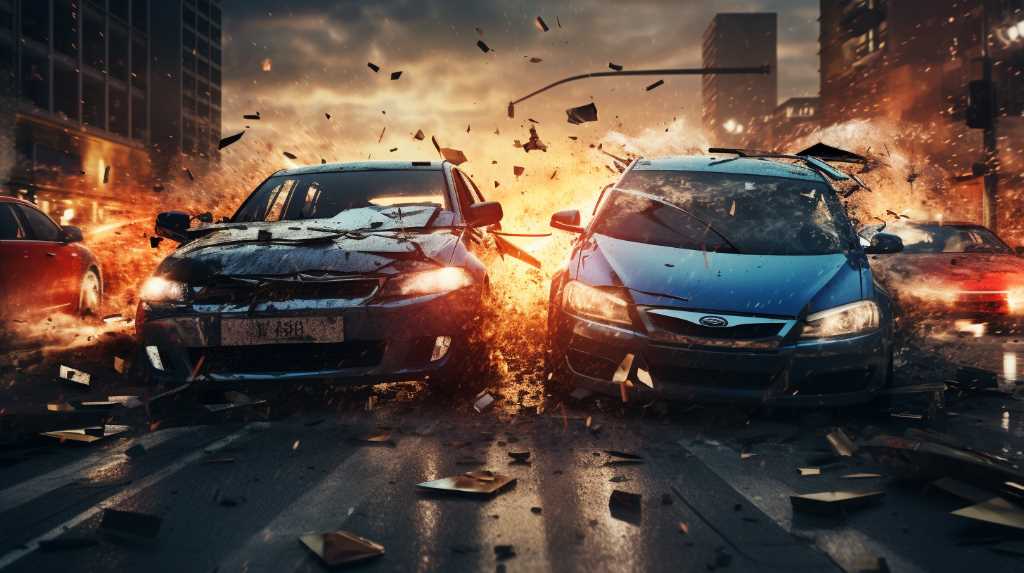
Car crashes are a major cause of harm and death across the globe. Some accidents are more dangerous than others.
Head-on crashes are very deadly because when two cars hit each other head-on, the force is huge.
Side-impact crashes, also known as T-bone crashes, can cause serious injuries because car doors don’t offer much protection.
Rollover accidents are also very bad because the car flips over, which can throw people out of the car and cause multiple hits.
When cars crash at high speeds, the force is much stronger, making the accident worse.
Big crashes involving many cars can make it hard for rescue teams to help and might cause more injuries.
Knowing about these kinds of crashes helps make cars safer and can save lives on the road.
Head-On Collisions Explained
Head-on crashes happen when the fronts of two cars going in opposite directions hit each other. Sadly, these crashes often lead to deaths. They’re so dangerous because the speed of both cars adds up, making the crash much harder. Looking closely at crash reports, we can see that these crashes usually happen when a driver makes a mistake—like drifting into the wrong lane because they’re distracted, tired, or under the influence. By studying where and how these crashes happen, we can spot places where they’re more likely.
To make roads safer and stop these terrible crashes, things like better signs, clearer road lines, and barriers in the middle of the road really help. These changes come from studying crashes and figuring out what works to prevent them. It’s important to keep looking at the data and improve road safety plans to save lives.
The Perils of T-Bone Crashes
Crashes where one car hits the side of another are called T-Bone crashes, and they’re very dangerous. The sides of cars aren’t as strong as the front or back, which can take a hit better. When a car gets hit on the side, it can crush into the area where people sit, which can cause serious injuries or even death.
A big number of the deaths from car crashes happen this way. Even though airbags on the side of a car and stronger sides can help, they don’t get rid of the danger completely.
Most T-Bone crashes happen at city crossroads, so these places are key for making cars safer and making sure everyone follows the traffic lights to avoid these kinds of crashes.
Rollover Accidents Uncovered
Vehicle rollover incidents, characterized by a car tipping onto its side or roof, constitute a significant hazard due to their high fatality rate and potential for severe occupant injury. Analyzing data from traffic safety agencies reveals that rollovers, although accounting for only a small percentage of total accidents, result in a disproportionately high number of vehicular deaths.
Various factors contribute to rollovers, including vehicle type, speed, and driver behavior. SUVs and pickups, with their higher centers of gravity, are more susceptible to rollovers compared to lower-profile cars. Excessive speed exacerbates the likelihood of a loss of control, which can lead to a rollover, especially in situations involving sharp turns or collision avoidance maneuvers.
Methodical investigation into these factors is essential for developing strategies to mitigate the risks associated with rollover accidents.
High-Speed Impacts Dissected
High-speed collisions often result in catastrophic outcomes, with the force of impact dramatically increasing the potential for severe injury or fatality. When two vehicles collide at high speed, the energy transferred is proportional to the square of the speed at the moment of impact, as dictated by the laws of physics. This exponential relationship underscores why high-speed impacts are particularly destructive.
Occupants are subjected to extreme deceleration forces, which can lead to life-threatening trauma, especially when safety restraints are not used or fail under stress.
Analyzing crash data reveals that high-speed impacts disproportionately contribute to traffic-related deaths. The structural integrity of a vehicle may be compromised at high speeds, lessening the effectiveness of crumple zones and safety features designed to absorb impact energy.
Consequently, proactive measures, including stringent speed enforcement and advanced safety technologies, are critical in mitigating the risks associated with high-speed collisions.
Multi-Vehicle Pileups Demystified
Multi-vehicle pileups are dangerous events on the road. Lots of cars crash into each other, often leading to serious injuries or even death. These crashes can be confusing and difficult to deal with, even for the best emergency teams. When we look closely at these pileups, we see they often happen because it’s hard to see, the weather is bad, or traffic suddenly stops.
Each extra car that crashes can make things worse. It makes it harder for rescuers to help and increases the chances of people getting really hurt. Looking back at these big crashes, we learn that keeping a safe distance from the car in front and paying attention while driving can help stop these terrible pileups from happening.
Conclusion
Car accidents can be very dangerous, and some kinds are worse than others.
Head-on crashes are especially bad because the cars hit each other directly, which can cause serious injuries.
Side-impact collisions, also known as T-bone crashes, are dangerous because the sides of cars don’t protect as well as the front or back.
Rollover accidents are scary because the car flips over, which can hurt people inside the car in many ways.
When cars crash at high speeds, the force is much stronger, leading to more damage to the car and more serious injuries for the people.
Also, when many cars crash together, like in a pileup, it’s harder for rescue teams to get to everyone, and it’s more complicated to figure out who is at fault.
All these kinds of accidents can make the roads very unsafe.